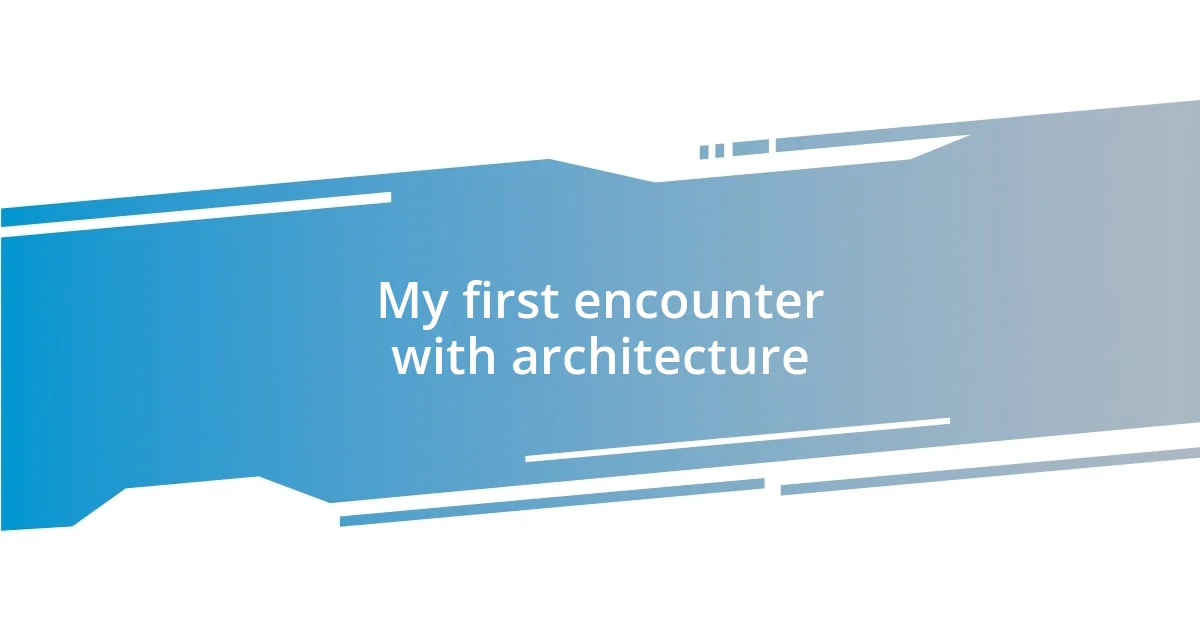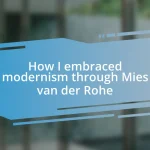Key takeaways:
- The author’s fascination with architecture began at a young age, sparked by visiting a museum and contemplating the emotional narratives of buildings.
- Discovering Frank Lloyd Wright’s work, especially Fallingwater, deepened the author’s understanding of organic architecture and the harmony between structures and nature.
- Experiencing Fallingwater in person highlighted the emotional impact of architectural design, showing how it can create profound feelings of peace and connection to the environment.

My first encounter with architecture
I still remember the moment I first stepped into a grand building that seemed to whisper stories from the past. I was around ten years old, wandering through a local museum, and I was captivated by the intricate details of the columns and the way the sunlight poured through the tall windows. It struck me then—how does something so solid, so unyielding, hold such warmth and meaning?
As I stood in awe, I couldn’t help but wonder about the minds behind these creations. Who designed them? What inspired them? I felt a spark ignite within me, a fascination with how architecture could shape emotions and tell the narratives of its inhabitants. That curiosity lingered; was it just the beauty of the walls, or was there something deeper at play, a connection between people and the spaces they occupy?
Days turned into weeks, and that initial awe blossomed into a profound interest. I began sketching my ideas and dreaming of creating spaces that would evoke emotions just like the museum did for me. There was something romantic in the way architecture could connect the past with the present—a bridge across time that I longed to explore.

Discovering Frank Lloyd Wright’s work
As I dove deeper into my architectural journey, Frank Lloyd Wright’s work surfaced like a beacon of inspiration. I remember flipping through an old architecture magazine, and there it was—the iconic Fallingwater. I felt a rush of excitement seeing how the structure seemed to breathe with the surrounding nature. That moment sparked a realization: Wright’s designs weren’t just about buildings; they were about creating harmony between humanity and the environment.
- Wright’s philosophy of organic architecture aims to create a connection between the built environment and nature.
- Fallingwater exemplifies this, seamlessly integrating the home with the waterfall it overlooks.
- His use of horizontal lines and open spaces evokes a sense of tranquility and balance, stirring emotions I hadn’t felt before.
- Visiting the Guggenheim Museum later on deepened my understanding of how structure can evoke movement, guiding visitors through a spiral that feels both intimate and expansive.
Discovering Wright’s work felt like unearthing hidden gems that echoed my desires—architecture that truly resonates with the human experience. Each piece I encountered layered my appreciation for his philosophy, drawing me in with its emotional depth. This journey opened a new world to me, where buildings became living, breathing entities, waiting to tell their stories.

Experiencing Fallingwater in person
Experiencing Fallingwater in person is nothing short of enchanting. As I approached the famed structure, nestled amid the vibrant greenery and the soothing sounds of the waterfall, I felt a wave of anticipation wash over me. The sight of the house perched above cascading water sent shivers of excitement through me; how could something so bold feel so seamlessly woven into its environment?
Once inside, I was immediately struck by the enormous windows that frame breathtaking views of the nature beyond. Each room felt like a quiet conversation between the home and its surroundings. I remember standing in the living area, overwhelmed by the way the light danced through the spaces, painting gentle shadows across the floors. It was a reminder of Wright’s genius—how he designed this space to let nature infiltrate the very atmosphere of living.
Just imagining sitting on the terrace, listening to the water below, I began to understand why Fallingwater is often hailed as a masterpiece. I felt an unexpected sense of peace envelop me, urging me to breathe deeply and let go of my everyday worries. It’s moments like these that make you question the boundaries of architecture—how could a single place stir such profound emotions and tranquility? Fallingwater was more than just a house; it was an experience that connected me to something larger, inspiring my own dreams of creating spaces that resonate with heart and soul.














